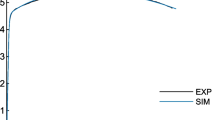Abstract
The contact problem on interaction of rigid stamps with anisotropic plates with regard to wear and the corresponding frictional heating is considered. The procedure developed is based on the reduction of the governing equation to a system of Volterra integral equations of the second kind. The numerical analysis allows us to study the effects of both the anisotropic thermoelastic characteristics of materials and the nature of the interaction of the contact-pair elements on the wear process.
Similar content being viewed by others
Abbreviations
- x,z :
-
Cartesian coordinates
- f :
-
friction coefficient,
- K :
-
coefficient of wear intensity
- V :
-
rate of relative motion of contacting bodies
- U, W :
-
displacements of an arbitrary point of a plate in the directionsx andz
- T :
-
temperature of a plate
- u, w, y :
-
displacements of points of the midsurface of a plate and rotation angle, respectively,
- p k (z/h) :
-
Legendre polynomials
- 2h, 2l :
-
thickness and width of a plate
- α(t) :
-
contact region
- N, M, Q :
-
generalized force, moment, and shear force, respectively
- v, α T ,E, v′, α′ T ,E′ :
-
Poisson ratios, coefficients of linear expansion, and Young's moduli in the plane of isotropy and in the plane perpendicular to it, respectively,
- G' :
-
shear modulus
- λ xx , λ zz :
-
coefficients of thermal conductivity in the directionsx andz
- αz :
-
coefficient of temperature conductivity
- \(\tfrac{{\partial w_* }}{{\partial t}}\) :
-
wear intensity
- α(t):
-
rigid displacement of a stamp
- f(x) :
-
function describing the profile shape of a stamp
- H :
-
coefficient of thermal permeability of the contact
- αh.f :
-
distribution coefficient of heat fluxes
- λi,c i,p i :
-
coefficients of thermal conductivity, specific heat capacity, and density of materials of a frictional pair, respectively
- λ* :
-
coefficient accounting for the effect of compression of an element normal to the midsurface of the plate
- t :
-
current time
- R :
-
radius of curvature of the stamp at pointx=0
References
V. M. Aleksandrov and E. V. Kovalenko, “Mathematical methods in contact problems with wear,” in: Nonlinear Methods and Problems of the Mechanics of a Deformable Body [in Russian], Nauka, Moscow (1984), pp. 77–85.
E. D. Brown, Yu. Evdokimov, and A. V. Chichinadze, Modeling of Friction and Wear in Machines [in Russian], Mashinostroenie, Moscow (1982).
I. G. Goryacheva and M. N. Dobychin, Contact Problems in Tribology [in Russian], Mashinostroenie, Moscow (1988).
D. V. Grilitskii, Thermoelastic Contact Problems in Tribology [in Ukrainian], Kiev (1996).
B. L. Pelekh and M. A. Sukhorol'skii, Contact Problems of the Theory of Elastic Anisotropic Shells [in Russian], Naukova Dumka, Kiev (1980).
M. M. Khruschev and M. L. Babichev, Abrasive Wear [in Russian], Nauka, Moscow (1970).
Ya. S. Podstrigach, V. A. Lomakin, and Yu. M. Kolyano, Thermoelasticity of Bodies of Nonuniform Structure [in Russian], Nauka, Moscow (1984).
M. Comninou, J. R. Barber, and J. Dundurs, “Heat conduction through a flat punch,” J. Appl. Math.,48, 871–874 (1981).
Ya. S. Pidstryhach, “Conditions of the thermal contact of solid bodies,” Dokl. Akad. Nauk USSR,7, 83–91 (1963).
B. L. Pelekh, A. V. Maksymuk, I. M. Korovaichuk, Contact Problems for Laminar Elements of Structures and Bodies with a Coating [in Russian], Naukova Dumka, Kiev (1988).
H. S. Kit and A. V. Maksymuk, “Method of Volterra integral equations in contact problems for thin-walled elements of structures,” Teor. Prikl. Mekh.,27, 29–35 (1997).
I. V. Kragel'skii, Friction and Wear [in Russian], Mashinostroenie, Moscow (1968).
Additional information
Pidstryhach Institute of Applied Problems of Mechanics and Mathematics, National Academy of Sciences of Ukraine, Lviv, Ukraine. Translated from Mekhanika Kompozitnykh Materialov, Vol. 35, No. 3, pp. 309–318, May–June, 1999.
Rights and permissions
About this article
Cite this article
Kit, H.S., Maksymuk, A.V. Waer of composite thin-walled structural elements with consideration of thermal effects. Mech Compos Mater 35, 213–222 (1999). https://doi.org/10.1007/BF02257251
Received:
Revised:
Issue Date:
DOI: https://doi.org/10.1007/BF02257251




